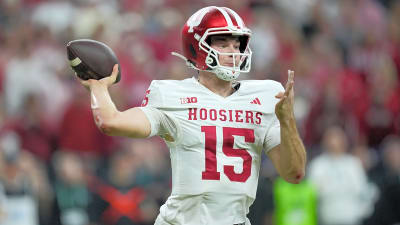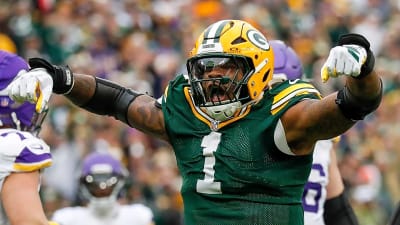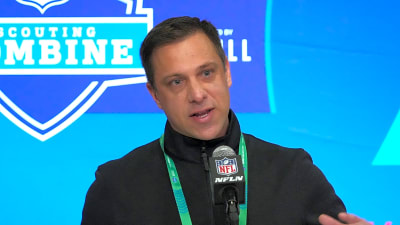
Terrell Davis and LaDainian Tomlinson: Running back two historic careers
Football exists through the prism of diametrically opposite kinds of players: those who create the brutal nature of the sport and those who try to avoid it. This isn’t necessarily a split between offensive and defensive players, but a split between the overly simplified ethos of a complicated game. For the most part, running backs belong to the latter group. There have been plenty of bruisers over the years, but those who define the position do so with elite athleticism, vision and grace. The running backs, not the signal callers, keep today’s NFL tied to the roots of the earliest years of football, but it’s the same position that continues to lose importance in contemporary offenses. That's why this year’s Hall of Fame inductees Terrell Davis and LaDainian Tomlinson are so important — they show what the position can become when it’s at its peak value, something we just don’t get in today’s game anymore.
Despite what both Davis and Tomlinson meant to their respective teams and the running back position at large, there were few similarities between the two. Davis had an incredible two-year stretch in which he was arguably the best running back in football in an era rife with excellent running backs. Tomlinson had a longer, more vibrant career with his 2006 season being one of the best for any football player ever. Both men had peaks worth remembering — Davis’s 2,000-yard rushing season and Tomlinson’s 31 combined rushing and receiving touchdowns — but even their peaks are remembered completely differently.
Davis’s 2,000-yard regular season preceded an equally impressive postseason in which he recorded 199, 167 and 102 yards in the Broncos' Super Bowl run, which ended with Davis recording at least 100 yards in seven consecutive playoff games. During the Broncos’ 1998 Super Bowl victory over the Falcons, Davis was still able to eclipse the 100-yard mark with Atlanta’s defenders determined to keep Denver's star back from beating them. The secret to Davis’s success wasn’t just the zone blocking scheme implemented by head coach Mike Shanahan and offensive line coach Alex Gibbs, but it was Davis’s patience and willingness to run north as opposed to east and west at all costs like some of his contemporaries.
When you watch his film, what stands out is the number of times he’s tackled from behind. Davis didn’t have the breakaway speed of some other elite halfbacks, but his vision and power were next level. Davis had amazing agility for a man his size, but his patience at the line of scrimmage and his willingness to run through anyone not donning the orange and blue gave the Broncos their edge. Before Davis became a Bronco, Denver only saw five rushers eclipse the 1,000-yard mark for a season in five of the previous 20 years. Davis did it in his first four and likely would have continued had it not been for an all but career-ending knee injury, not to mention those pesky migraines.
What was most striking about watching Tomlinson play was the number of times defenders who had an angle on LT running up the sideline yet still failed to lay a finger on him. His speed was as intimidating as his dark, tinted visor. Tomlinson was as complete a football player there was in the 2000s, leading all rushers with 12,490 yards during the decade. When Reggie Bush was in high school, he had a chance to work out with Tomlinson, who told him, “being a running back was like being an artist,” and no running back painted a better picture of what that position could accomplish during LT’s time in the NFL. He ran by, through and around defenders. He caught the ball out of the backfield and even threw a few touchdown passes.
There wasn’t anything Tomlinson was incapable of doing on the field, but he didn’t have the same kind of team success that Davis had. Philip Rivers and Antonio Gates served as excellent additions to what LT started to build in San Diego, and the team was able to reach the AFC title game off the strength of that trio. Still, Tomlinson’s individual success was never matched by his team. We’ll always remember what he was able to accomplish despite playing on teams ranging from mediocre to pretty good because he always exceeded what we previously thought was within the realm of capabilities for a running back. He was one part Marcus Allen, two parts Marshall Faulk and a splash of Curtis Martin.
Beyond that, and above all, Tomlinson continued to bring us back to the fundamental nature of why football should exist: He was just really fun to watch. On the field with some of the greatest athletes in the world, LT articulated the dynamism that we saw in ourselves as weekend warriors. What we wanted to accomplish against our friends and families on Thanksgiving mornings is what Tomlinson was able to do almost every single Sunday for 11 years.
Tomlinson was around long enough to pile up numbers comparable with some of the other running backs in the Hall of Fame, while Davis's six years had to be looked at in a vacuum to allow him in. Even if a running back’s career lasts longer than average, his impact for his teams and on the game is often ephemeral at best, and more than any other position in sports, we shouldn’t punish running backs who were elite for a handful of years because of a lack of longevity. The punishing nature of the position lends itself for short careers. On average, the length of an NFL career is a little over three years; for running backs, it’s even shorter at two and a half — the lowest among all skill position players.
While LT was able to push beyond the years that are usually taken from backs, both he and Davis end up in the same place: Canton, Ohio, enshrined for eternity. For Davis, the Hall of Fame gives him a kind of immortality in a profession predicated on impermanence. For Tomlinson, he’s earned what was always going to be his. Greatness, as these two have shown, comes in all forms, and going back through their careers, we’re rekindled with two of the best running backs the game has seen. There is no other perspective to be had, just a promise that they’ll both be remembered forever.
More must-reads:
- LaDainian Tomlinson shares cool tweet ahead of Hall of Fame weekend
- Terrell Davis: 'I believe in Trevor' Siemian, expects him to start
- The 'Most touchdowns scored in NFL history' quiz
Customize Your Newsletter
 +
+
Get the latest news and rumors, customized to your favorite sports and teams. Emailed daily. Always free!








